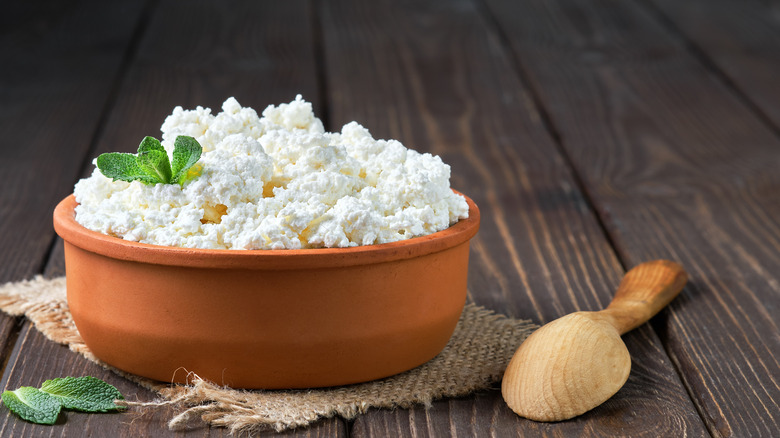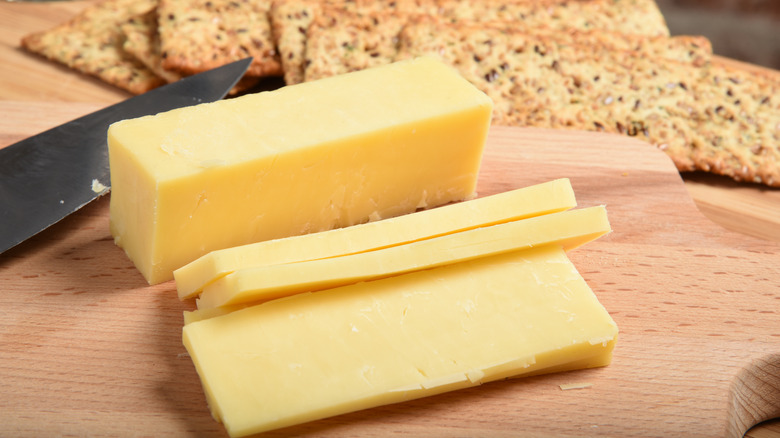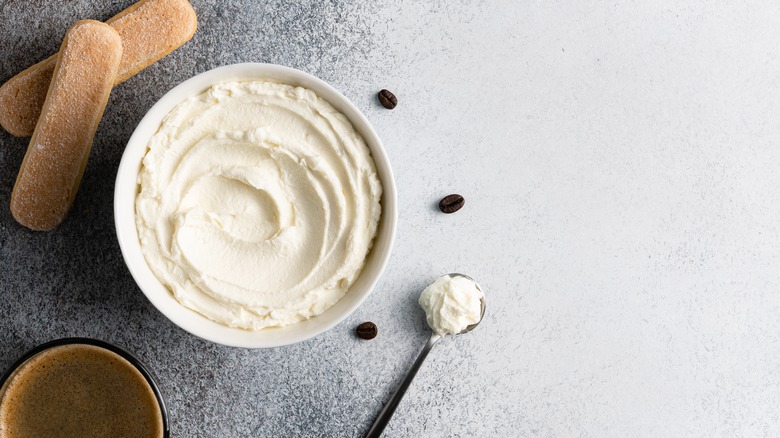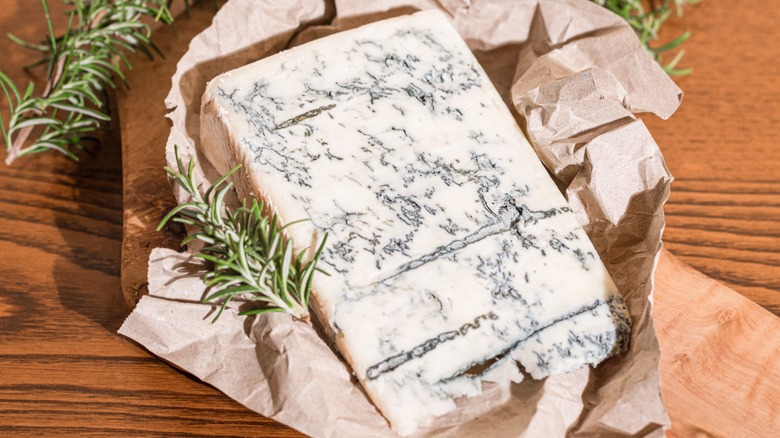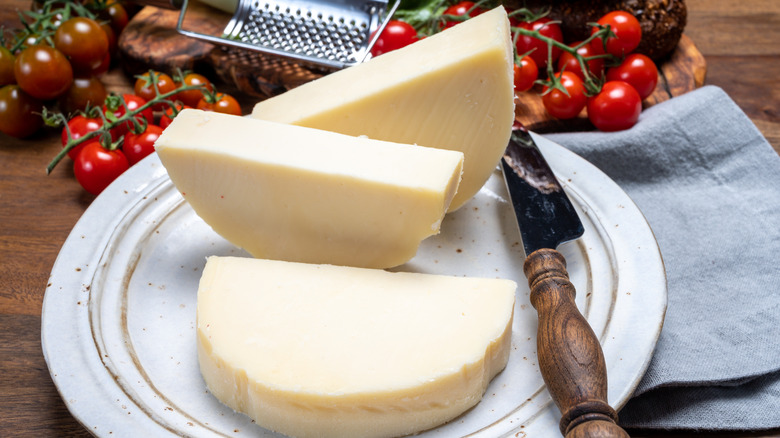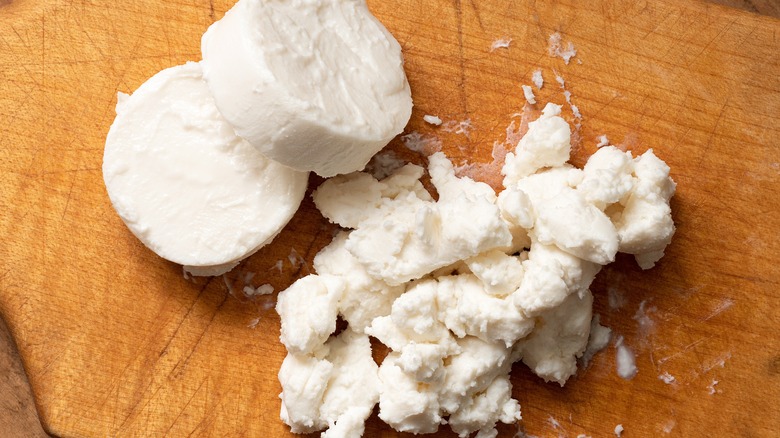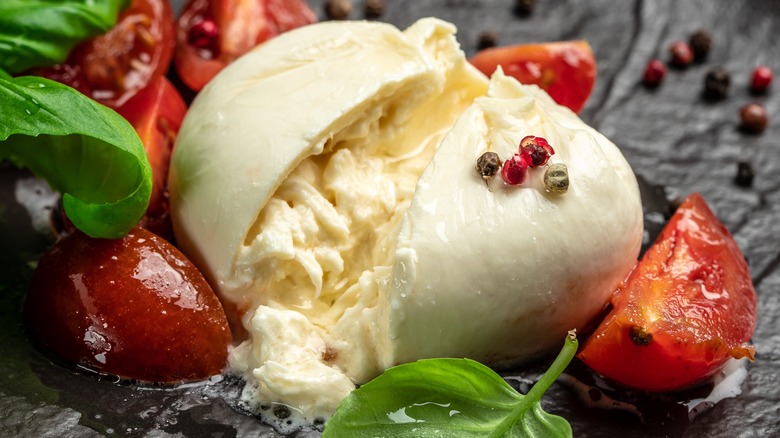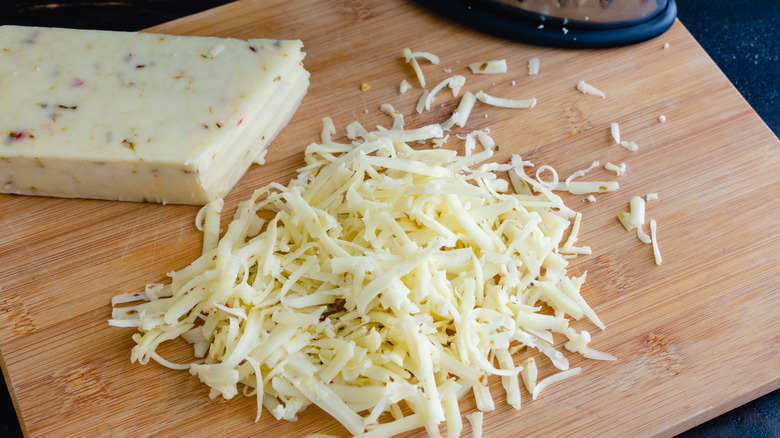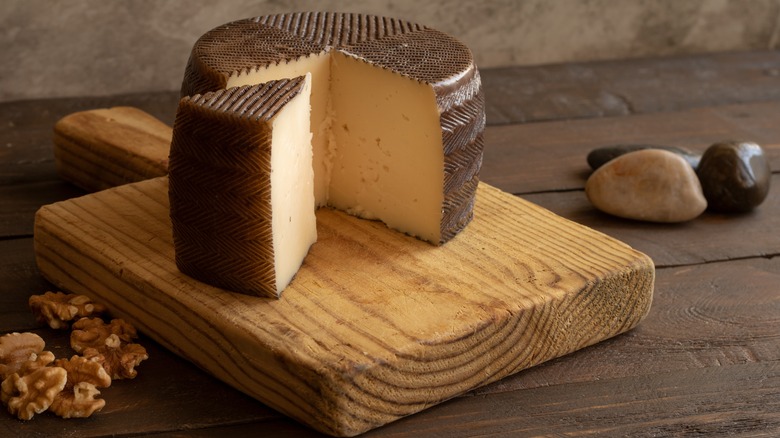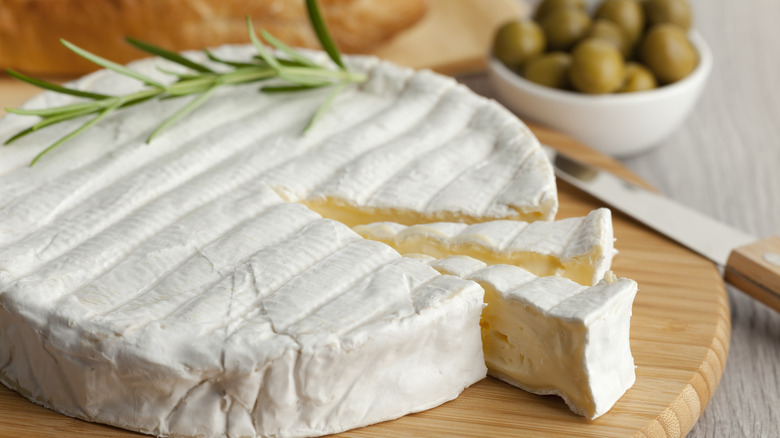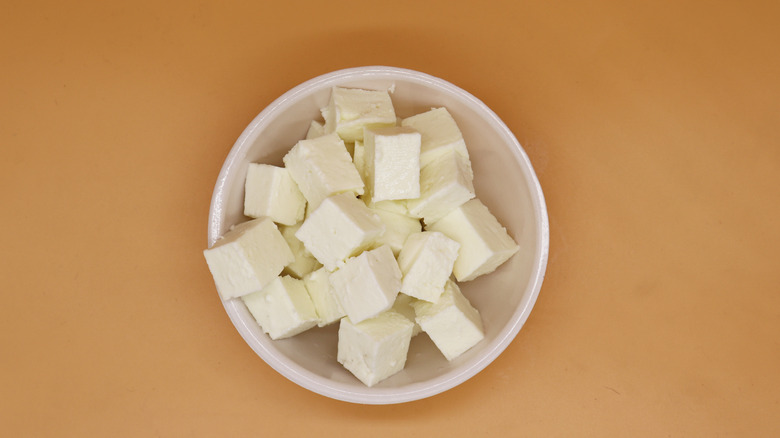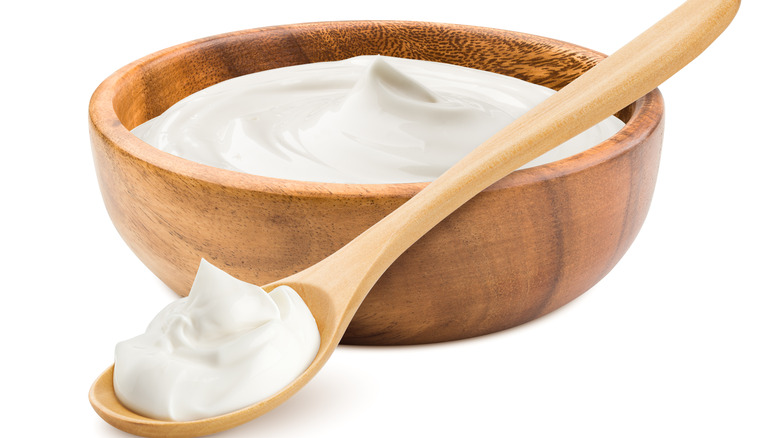Unique Cheeses You Should Be Using In Lasagna
Lasagna is one of those comforting, delicious, crave-worthy dishes practically everyone enjoys, no matter the season, meal, or location. Its versatile and crowd-pleasing flavors make it the perfect family meal or potluck addition. And while some Italian dishes get a bad rap for heaviness and a high fat content, lasagna can present some redeeming health qualities like hearty amounts of protein, energizing carbohydrates, vitamins, and minerals — depending on the ingredients involved, of course.
Typically made with ground meat, lasagna noodles, tomato sauce, mozzarella, ricotta, and herbs, lasagna is easy for any home cook to prepare. It's also a base for creativity If you're tired of making the same traditional recipe or you're short on ingredients like mozzarella or ricotta cheese, then you can try mixing it up with another cheese you have on hand. If you're trying to increase your creativity in the kitchen, pick up a fancy cheese and give your classic lasagna recipe a twist. Check out our list for ideas and inspiration to take your Italian pasta night to the next level with the introduction of a new and unique cheese.
Cottage cheese
A classic swap for ricotta in lasagna recipes, cottage cheese is not only great in a pinch, but it's also low-calorie and packed with protein. The best way to substitute cottage cheese for ricotta is to drain any liquid and then blend it until the cheese comes together with a creamy texture similar to ricotta.
Both ricotta and cottage cheese are soft, creamy, white cheeses. However, ricotta is derived from the liquid that's separated from curds, also known as whey. Meanwhile, cottage cheese comes from the more solid curds. Cottage cheese is also typically enjoyed straight out of the fridge, whereas ricotta is more often added to Italian recipes like stuffed shells, pizza, cannoli, ravioli, and lasagna.
When it comes to healthier alternatives, swapping cottage cheese for ricotta will help cut some fat, cholesterol, and calories from your lasagna recipe, as per Healthline. The exact nutrients, as well as sodium and fat levels, will depend on the brand of cottage cheese. This cheese is also generally high in protein and vitamin B12.
Cheddar
It's hard not to love a hard cheese like cheddar, making it a delicious and crowd-pleasing addition to your lasagna recipe. Cheddar cheese comes in a multitude of styles and flavors from mild to sharp and beyond. It's a bit high in saturated fats and cholesterol, but it's also rich in calcium, one of the most important nutrients for bone health (via WebMD). When incorporating melted cheddar into recipes, use sharp cheddar as it delivers more flavor than mild varieties and can stand up to other bold flavors like the tomato sauce and herbs often found in lasagna.
Although considered a renegade choice for Italian dishes, some GardenWeb commenters liken a cheddar cheese lasagna to layered goulash. Reddit users agree that it's a viable addition to lasagna, so long as it's high-quality cheddar. Another option is to use a half-cheddar, half-mozzarella mixture, in which case a sharp, shredded white cheddar would work well for both taste and color.
Mascarpone
Hailing from northern Italy, mascarpone is a rich, creamy cheese that's high in butterfat and made from cow's milk. You can make your own mascarpone at home using heavy whipping cream and acid, as well as a cheesecloth for straining.
While mascarpone is often used in desserts like tiramisu, its flavor is saltier and nuttier than ricotta, while it's also more creamy. Both may be used in sweet or savory dishes, so mascarpone makes for a good substitute for ricotta in lasagna. That's especially handy if you don't have ricotta and you do have heavy whipping cream and a lemon. The only other thing you'll need is time, as homemade mascarpone needs about half a day to thicken.
However, you may want to use mascarpone sparingly in your lasagna as it has a much higher fat content than ricotta, with double the amount of fat as cream cheese. You may also want to try adding Italian herbs to the mix to give mascarpone more depth and texture.
Gorgonzola
Gorgonzola is a type of blue cheese that originated in the Lombardy and Piedmont region of Italy. For gorgonzola to be considered real gorgonzola, it has to have the DOP stamp that translates to and denotes a Protected Designation of Origin, so be on the lookout for this seal of approval.
Gorgonzola can be identified by the blue and green marbling throughout the cheese, which gives it a zesty, bold flavor and crumbly texture. Gorgonzola is a variety of blue cheese, though gorgonzola is made from unskimmed cow's milk and is aged differently than other types of blue cheese. There are two types of gorgonzola: sweet and mild (gorgonzola dolce) and the more pungent gorgonzola piccante.
For lasagna and other cooking applications, look for gorgonzola dolce, as this sweeter style of cheese is easier to spread and less crumbly. There are many ways you could incorporate gorgonzola into lasagna. Consider melting and mixing it with ricotta for extra tangy flavor throughout the layers of your lasagna. Or you could crumble gorgonzola piccante on top to give your lasagna a more pungent and colorful finish. Lastly, try drizzling your lasagna with a gorgonzola cream sauce.
Provolone
A close cousin to mozzarella, provolone comes from Southern Italy and is a standard cheese selection at any deli counter in the U.S. Known for its mild, subtly nutty taste and smooth texture, provolone works well in any sandwich and can be enjoyed raw or melted. Like mozzarella, provolone is made through curdling milk, which is spun, stretched, and aged to perfection.
Similar to gorgonzola, provolone also has two Italian varieties. One is provolone piccante, which is more pungent, firm, and easy to grate. The second is provolone dolce, often used on pizzas and in pasta or melted onto a meatball sub. There is a third type of provolone that is only recognized in America, which is the kind sold in packaged slices in the deli section of your grocery store. American provolone typically uses vegetarian enzymes rather than animal-derived ones in the curd separation process, making it a soft, light, and mild style of provolone cheese.
Any of the above varieties could be substituted for mozzarella in lasagna. However, American or dolce may be the best option as they melt better than piccante. For an extra-cheesy lasagna, you could also layer provolone along with mozzarella.
Goat cheese
If you have an allergy to cow's milk cheeses, goat cheese may be your best bet for lasagna. Goat cheese, also known as chèvre, is any type of cheese that is made from goat's milk. In addition to being a great substitute for cow's milk, goat cheese is also high in proteins, probiotics, and vitamins, and it may even act as an anti-inflammatory (via Healthline).
The tangy, creamy flavor of goat cheese is not for everyone. However, if you do have a taste for it, Ina Garten recommends elevating your next lasagna with this type of cheese. Her recipe includes many of the staples you'd find in lasagna, including onions, garlic, tomato sauce, ricotta, mozzarella, and ground meat (Garten's choice is ground turkey, but ground beef would work too). She then adds goat cheese to the ricotta and layers the mixture with the other ingredients. Goat cheese also helps lend a creamy, binding texture that every lasagna needs.
Burrata
Burrata may just have the most interesting backstory of any cheese in the deli. It's not in every grocery store, but many high-end markets and restaurants carry it on their shelves and menus. Derived in the 1920s in Italy's Apulia region, the cheese came from cows that were an important food source for the people in the surrounding mountains. To preserve the precious milk, farmers looked for ways to utilize leftovers from the cheesemaking process, and thus burrata was born.
In Italian, burrata translates to buttery, so it's no wonder this creamy, mozzarella-style cheese pairs well with pasta, pizza, and just about every Italian dish you can think of. Burrata is a fresh cheese that resembles fresh mozzarella, with a thin shell on the outside, and a creamy, stringy center that you can practically twist around your fork like spaghetti.
If you're looking to up the buttery, creamy taste and texture of your lasagna, you could certainly use the more decadent version of mozzarella, so long as you use fresh burrata. You could also try making your own ad-hoc burrata for lasagna by adding cream to fresh mozzarella.
Cream cheese
Like peanut butter is to chocolate, cream cheese is to bagels. But this creamy, acidic yet mild, and spreadable cheese is more versatile than you might think. Typically made from cream and milk, store-bought cream cheese also includes salt, carob bean gum, and cheese cultures, according to Health. Cream cheese is also a good source of vitamins and is also high in fat, but low in carbs and protein. As cream cheese is often a full-fat dairy product, whipped cream cheese is a slightly lighter option as it contains less fat and fewer calories per serving compared to regular cream cheese.
If you're searching for a classic lasagna recipe with a twist, try adding cream cheese between your layers of lasagna noodles. To work with your cream cheese, soften it by leaving it unrefrigerated for roughly one hour. Cream cheese may not be the lasagna standard, but it lends a creamier style to your ricotta by eliminating some of the grainy texture while giving it a more acidic flavor.
Pepper jack
If you want to put a spicy twist on your next lasagna recipe, look no further than pepper jack cheese to turn up the heat on this classic Italian dish. Pepper jack is a semi-soft style of cheese that was developed in the United States. Jalapeños, serrano peppers, and habañero peppers are typically infused into Monterey jack cheese, giving it a spicy, buttery flavor that can pack a lot of heat.
Pepper jack is very versatile and can be used with burgers, eggs, grilled cheese sandwiches, and unconventional Italian dishes like lasagna. If you're tired of making the same old lasagna, try switching it up with a Mexican-style take on classic lasagna, where black beans, corn, chiles, tomatoes, green onions, tortillas, chicken, and a blend of spices will take your meal to the next level. Layer the ingredients with the tortillas acting as noodles, and use pepper jack cheese in place of mozzarella to give your lasagna a kick. Sliced jalapeños will increase the spice, while sour cream and cilantro work as the perfect garnish.
Manchego
Originating from Spanish Manchego sheep, manchego cheese is a perfect alternative for anyone allergic to cow's milk or those who want to add a nutty flavor to their dishes. Depending on how long it has been aged, manchego can either be soft and creamy or hard and crumbly after it's aged up to two years. The rind is inedible, but once you get past the exterior, you'll find a toasty, mild cheese that resembles parmesan or romano.
This sheep's milk cheese can be used in pesto sauces, sprinkled on spaghetti, or served straight up on a charcuterie board. If you're looking for a twist on your lasagna or one of your guests has a dairy allergy, try swapping manchego for parmesan in your lasagna. It doesn't melt quite as easily as mozzarella or other soft, fresh cheeses, but it does grate perfectly on top to give you the sprinkled texture and taste of parmesan with its own unique flavor.
Brie
A soft, creamy, cow's milk cheese with an edible rind, brie cheese is so beloved that it is one of France's most popular exports. Perfect for baking or eating chilled, brie pairs well with most fruits, crackers, and bread. This versatile cheese can also be adapted to use in a variety of recipes, from breakfast quiches to croissants to bruschetta and even lasagna.
Brie cheese is both a high-fat and high-nutrient cheese that contains protein, vitamins, and minerals, according to Healthline. The fat in brie cheese is mostly saturated fat from cow's milk, though the protein is equivalent to the amount found in one medium-sized egg.
While you could mix brie with ricotta in your lasagna to give the final dish a creamy, rich, and indulgent texture, there are other ways to incorporate this cheese. Try your hand at a creamy brie sauce drizzled on top of your lasagna or spread between layers.
Paneer
Paneer is a tofu-lookalike cheese typically made from cow or buffalo milk and which is sometimes referred to as "Indian cottage cheese." Paneer is often served as cubes in Indian curries and kabobs, as well as other dishes from India, Pakistan, Bangladesh, and Afghanistan. Although paneer is considered to be a fresh, soft cheese, it has a texture similar to tofu. Surprisingly for anyone unfamiliar with this cheese does not melt.
If you're looking to get creative in the kitchen and put a fun spin on your average lasagna, try swapping out paneer for ricotta. While you're at it, give your lasagna an Indian-style twist by using curry flavors in place of Italian tomato sauce and seasonings. The best way to incorporate paneer as a ricotta substitute would be to blend it in a food processor first to give it a more creamy, granular texture that mimics the look and feel of its more traditional lasagna counterpart.
Fromage blanc
A cheese that complements both sweet and savory dishes, fromage blanc simply means white cheese. Hailing from northern France and southern Belgium, fromage blanc is made with pasteurized cow's milk and is similar in texture to ricotta. Pure fromage blanc has virtually zero fat, but cream is almost always added to give it more depth of flavor, which makes it higher in saturated fats.
When shopping for fromage blanc, it's best to choose high-quality cheese that uses sustainable, high-quality milk. Fromage blanc is versatile and can be used as a dip or spread, or served as a dessert with fruit, or in a pastry filling.
Some fromage blancs have added ingredients like herbs or spices, so if you're using it in lasagna you'll want to make sure it's a plain fromage blanc or that the additions will work with your other ingredients. All told, fromage blanc is a great substitute for ricotta because it has a lower fat content and is creamier with no grainy texture.

